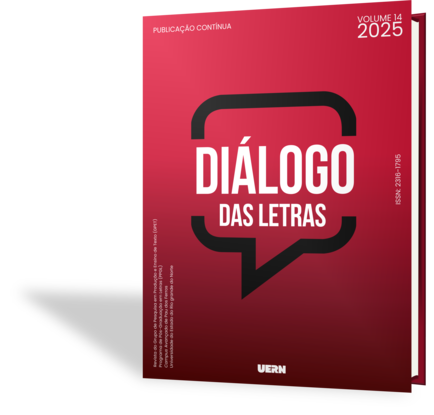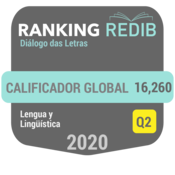Verbivocovisualidade e tecnografismo em práticas tecnodiscursivas: sentidos em construção no Instagram
DOI:
https://doi.org/10.22297/2316-17952025v14e02514Palavras-chave:
Verbivicovisualidade, Tecnografismo, Enunciação material visualResumo
O presente artigo buscou analisar a construção de sentidos em posts no Instagram a partir do uso do tecnografismo (compósito verbo-icônico característico das produções nativas digitais). A partir dos aportes teóricos de Mitchell (1986), Santaella (2007; 2015), Brait (2013), Paula e Serni (2017), Paula e Luciano (2020) e Paveau (2020; 2022), discute-se a integração das dimensões verbal, visual e sonora em uma enunciação material visual que redefine os modos de produção textual no ambiente digital. Com metodologia qualitativa e abordagem descritivo-interpretativista, foram selecionados e analisados dez posts relacionados aos ataques racistas sofridos pelo jogador Vinícius Júnior, afiliados pela hashtag militante #racistasnãopassarão, enfocando os recursos tecnolinguageiros utilizados na construção discursiva do ciberativismo antirracista. Os resultados revelaram o uso recorrente de práticas como a incrustação textual, manipulação de imagens e inserção de recurso sonoro, produzindo um discurso plurissemiótico que potencializa os efeitos de sentido e a força persuasiva das publicações analisadas. A pesquisa evidencia que o tecnografismo, ao articular aspectos linguageiros e tecnológicos, revela a plasticidade das produções digitais e desafia perspectivas analíticas centradas na separação entre códigos semióticos. Ao considerar a tridimensionalidade verbivocovisual dos enunciados, propõe-se uma percepção integrada das materialidades tecnolinguageiras. Foi possível concluir que o tecnografismo se consolida como prática tecnodiscursiva central na rede social Instagram, contribuindo para a construção de novos efeitos de sentido e para o fortalecimento de movimentos sociais, como o ciberativismo antirracista, em um ecossistema digital.
Downloads
Referências
BAKTHIN, M. Teoria do romance I: a estilística. São Paulo: Editora 34, 2015.
BRAIT, B. Olhar e ler: verbo-visualidade em perspectiva dialógica. Bakhtiniana, v. 8, n. 2, p. 43-66, jul./dez. 2013. Disponível em: https://revistas.pucsp.br/index.php/bakhtiniana/article/view/16568. Acesso em: 20 set. 2025. DOI: https://doi.org/10.1590/S2176-45732013000200004
CARNEIRO, S. Dispositivo de racialidade: a construção do outro como não ser como fundamento do ser. Rio de Janeiro: Zahar, 2023.
COSTA, J; PAVEAU, M-A. Imagem e discurso: uma enunciação material visual. Fórum Linguístico, v. 18, p. 5788-5795, jul./2021. DOI: https://doi.org/10.5007/1984-8412.2021.e82170. Acesso em 05 abr. 2024. DOI: https://doi.org/10.5007/1984-8412.2021.e82170
‘DEUS perdoe essas pessoas ruins’: frase de Gabigol foi tatuada por Adriano Imperador, ex-Flamengo. O Globo. Rio de Janeiro, Esportes, 16 nov. 2023. Disponível em: https://oglobo.globo.com/esportes/futebol/flamengo/noticia/2023/11/16/deus-perdoe-essas-pessoas-ruins-frase-de-gabigol-foi-tatuada-por-adriano-imperador-ex-do-flamengo-entenda.ghtml. Acesso em: 15 jun. 2024.
GUNTHERT, A. L’image conversationnelle. Études photographiques, v . 31, p. 1-16, 2014. Disponível em: http://journals.openedition.org/etudesphotographiques/3387. Acesso em: 20 set. 2025.
MITCHELL, W. J. T. Iconology: image, text, ideology. The University of Chicago Press, Chicago and London, 1986. DOI: https://doi.org/10.7208/chicago/9780226148052.001.0001
OLIVEIRA, D. de. O racismo estrutural deve ser discutido a partir das profundezas, não das superfícies: entrevista com Dennis de Oliveira. Entrevista cedida a Cláudia Nonato e Edilaine Heleodoro Felix. Comunicação & Educação, v. 30, n. 1, p. 197–205, jan./jun. 2025. Disponível em: https://revistas.usp.br/comueduc/article/view/234670. Acesso em: 25 jul. 2025. DOI: https://doi.org/10.11606/issn.2316-9125.v30i1p199-217
OLIVEIRA, D. de. Racismo estrutural: uma perspectiva histórico-crítica. São Paulo: Editora Dandara, 2021.
PAULA, L. de; LUCIANO, J. A. R. A filosofia da linguagem bakhtiniana e sua tridimensionalidade verbivocovisual. Estudos Linguísticos, v. 49, n. 2, p. 706-722, jun. 2020. DOI: https://doi.org/10.21165/el.v49i2.2691. Acesso em: 20 set. 2025. DOI: https://doi.org/10.21165/el.v49i2.2691
PAULA, L. de; SERNI, N. M. A vida na arte: a verbivocovisualidade do gênero filme musical. Raído. v. 11, n. 25, p. 178–201, 2017. DOI: https://doi.org/10.30612/raido.v11i25.6507. Acesso em: 17 ago. 2024. DOI: https://doi.org/10.30612/raido.v11i25.6507
PAVEAU, M.-A. "Feminismos 2.0: Usos tecnodiscursivos da geração conectada." In: COSTA, J. L.; BARONAS, R. L. (org.). Feminismos em convergência: discurso, internet e política. Grácios Editor: Coimbra, 2020. p. 21-50.
PAVEAU, M-A. Análise do discurso digital: dicionário das formas e das práticas. Tradução de Júlia Lourenço Costa e Roberto Leiser Baronas. Campinas-SP: Pontes, 2022.
SANTAELLA, L. Linguagens líquidas na era da mobilidade. São Paulo: Paulus, 2007.
SANTAELLA, L. Uma imagem é uma imagem, é uma imagem, é uma imagem… Tríade: comunicação, cultura e mídia, v.3, n. 5, p. 10-19, jun. 2015. Disponível em: https://periodicos.uniso.br/triade/article/view/2258. Acesso em: 20 set. 2025.
VOLÓCHINOV, V. A palavra na vida e a palavra na poesia: ensaios, artigos, resenhas e poemas. Organização, tradução, ensaio introdutório e notas de Sheila Grillo e Ekaterina Vólkova Américo. São Paulo: Ed. 34, 2019.
VOLÓCHNOV, V. Marxismo e filosofia da linguagem: problemas fundamentais do método sociológico na ciência da linguagem. Tradução, notas e glossário de Sheila Grillo e Ekaterina Vólkova Américo. Ensaio introdutório de Sheila Grillo. São Paulo: Editora 34, 2017
Downloads
Publicado
Como Citar
Edição
Seção
Licença
Copyright (c) 2025 Dayse Maciel Santos, Sônia Virginia Martins Pereira

Este trabalho está licenciado sob uma licença Creative Commons Attribution 4.0 International License.
A Diálogo das Letras não se responsabiliza por conceitos e opiniões emitidos pelos autores, tampouco manifesta, necessariamente, concordância com posições assumidas nos textos publicados. Além disso, os dados e a exatidão das referências citadas no trabalho são de inteira responsabilidade do(s) autor(es). Ao submeterem seus trabalhos, os autores concordam que os direitos autorais referentes a cada texto estão sendo cedidos para a revista Diálogo das Letras; ainda concordam que assumem as responsabilidades legais relativas às informações emitidas.


















